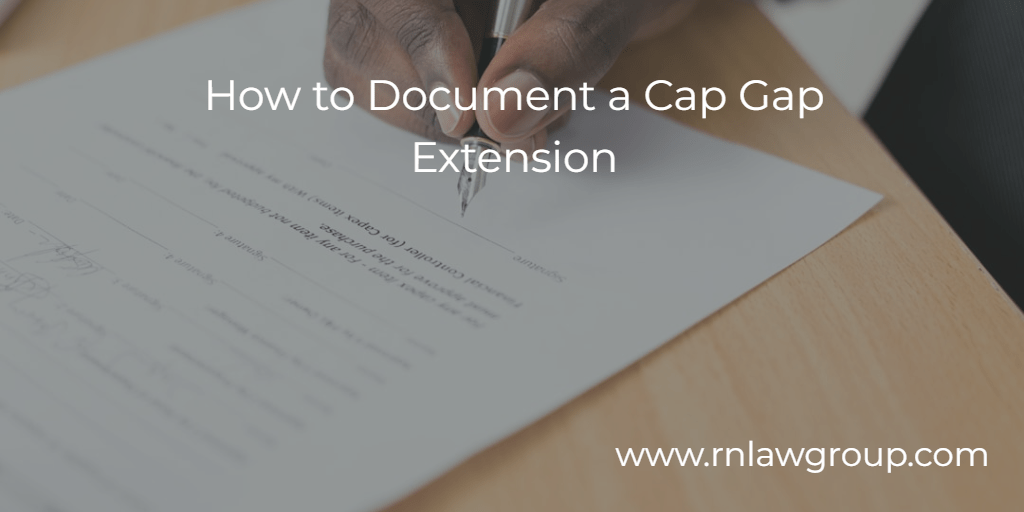
How to Document a Cap Gap Extension
For F-1 OPT employees who recently had a cap-subject H-1B petition filed on their behalf, it is important to understand the cap gap extension provision and the conditions necessary for continued work authorization.
What is the Cap Gap Extension?
A cap gap extension is needed for F-1 OPT (initial post-completion OPT or STEM OPT) workers who have been selected in the H-1B lottery, and whose EAD expires before September 30. Because the start date for all cap-subject H-1Bs is October 1 at the earliest (the start of the government’s fiscal year), a “gap” in status and work authorization can exist for F-1 OPT beneficiaries whose EAD expires before the H-1B can go into effect. The gap is remedied by a regulatory measure (8 C.F.R. § 214.2(f)(5)(vi)) that automatically extends the H-1B beneficiary’s F-1 OPT status and work authorization to September 30, as long as the following conditions are met:
- The H-1B petition was filed as a change of status.
- The I-129 form requests an employment start date of October 1 of the same year.
- The H-1B petition is timely filed before the beneficiary’s EAD expires.
The timely filing of the H-1B petition is important to note, as it makes the EAD expiration date the effective filing deadline (rather than June 30, which is the filing deadline for most cap-subject petitions selected in the March lottery).
The cap gap extension remains effective through September 30, as long as the I-129 petition is pending or approved. If the petition (or change of status request) is denied, withdrawn, rejected, or revoked prior to September 30, the beneficiary’s work authorization will terminate immediately, and the 60-day grace period will go into effect to enable them to depart the U.S., apply for another status, or re-enroll in school to continue their F-1 status.
If the H-1B petition remains pending after September 30, the beneficiary can remain in the U.S. in a period of authorized stay, but will not be authorized to work until the petition is approved and their status has been changed to H-1B. An upgrade of the petition to premium processing may therefore be necessary to avoid an employment gap, if it remains pending in early September.
Documenting the Cap Gap Extension
Assuming the above-listed conditions are met, how does an H-1B beneficiary document their continued status and work authorization? The beneficiary does not need to file an additional I-765 to apply for a separate EAD card; the cap gap authorization is considered automatic, and their employer can use the receipt notice for the filed and pending I-129 petition to re-verify the beneficiary’s work authorization.
The beneficiary can also provide their school’s DSO with a copy of the I-797 Receipt Notice, with which the DSO can update the student’s SEVIS record to add the cap gap extension through September 30 and issue an updated I-20. In the event that the petition is filed, but the receipt notice has not yet been issued by DHS, the beneficiary can provide the DSO with other proof of the petition’s timely filing, such as a copy of the I-129 form and the delivery confirmation from the post office or courier. This alternative proof of the petition’s filing will enable the DSO to issue an updated I-20 valid to June 1, after which the beneficiary should return with a copy of the I-797 receipt notice. Upon receiving the receipt notice, the DSO can update the I-20 again to be valid until October 1.
While the updated I-20 can serve as proof of continued work authorization, it is not required in order to allow the beneficiary to continue working. The cap gap extension is automatic, and the beneficiary may remain employed while the I-20 is in process. Their employer can use the receipt notice to re-verify the beneficiary’s work authorization, and will need to do so again by September 30 with the approval notice (if the petition has been approved by then).
Employers and beneficiaries utilizing the cap gap extension provisions should be aware of its conditions and its limits. H-1B beneficiaries and employers are encouraged to consult with qualified immigration counsel to ensure uninterrupted work authorization during the transition from F-1 OPT to H-1B status.
By: Rebecca Chen
Rebecca Chen is a Partner at Reddy & Neumann. Her representation includes advising clients throughout the non-immigrant and immigrant visa application process, from initial filing, responding to various requests for evidence, and processing at overseas consulates. Her years of experience in the immigration field have made her a knowledgeable resource for complex business immigration matters.

